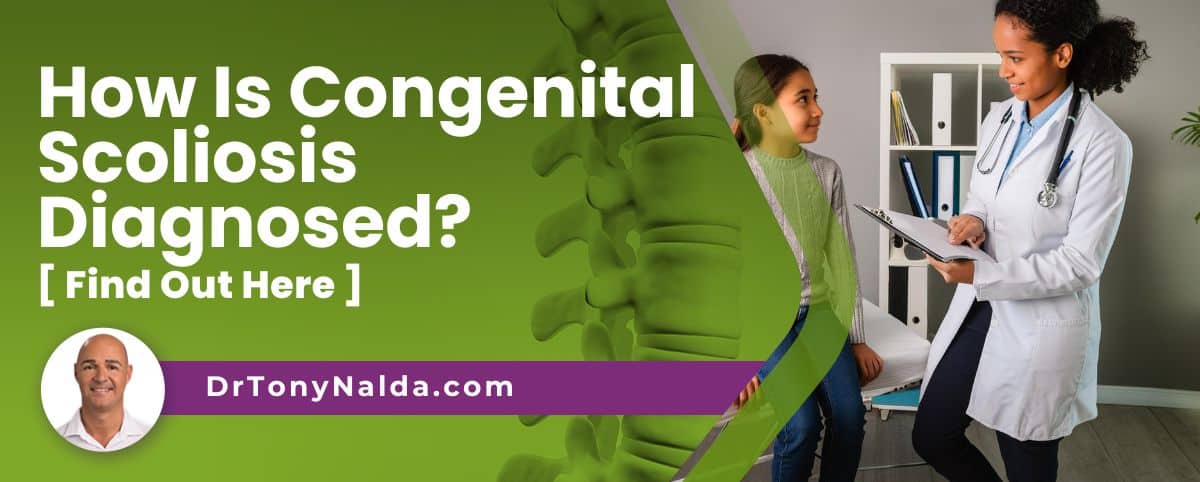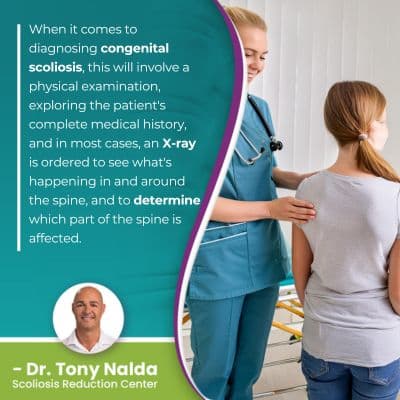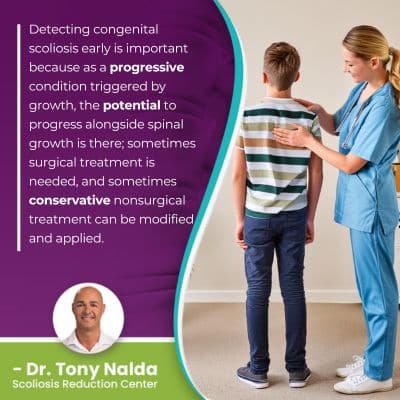How Is Congenital Scoliosis Diagnosed? [ Find Out Here ]

In the most common type of scoliosis, the cause is unknown, but atypical condition types are associated with known causes, and these types tend to be severe and have unique treatment needs. The complex nature of scoliosis necessitates the complete customization of effective treatment plans.
There are not only different severity levels of scoliosis ranging from mild to moderate and severe to very severe, there are also different condition types that can develop. Congenital scoliosis affects babies who are born with the condition due to a malformed spine that develops in utero.
Part of diagnosing scoliosis involves further classifying conditions based on key variables, one of which is condition type.
Table of Contents
Diagnosing Scoliosis
With current estimates at close to seven million people living with scoliosis in the United States alone, it is a highly-prevalent spinal condition that warrants awareness.
Diagnosing scoliosis means an unnatural sideways curvature of the spine has developed, and in addition to bending unnaturally, a scoliotic spine also twists, and it's the rotational component that makes scoliosis a complex 3-dimensional condition.
To be considered a true scoliosis, the size of the unnatural spinal curve has to be a minimum of 10 degrees, and this is determined by a patient's Cobb angle measurement.
An X-ray is needed to confirm a patient's rotational component and Cobb angle, and this involves drawing lines from the tops and bottoms of the curve's most-tilted vertebral bodies, and the resulting angle is expressed in degrees.
The higher a patient's Cobb angle, the more severe the condition, and the more in need of treatment a patient is; as a progressive condition, the nature of scoliosis is to get worse over time, and this means the size of the unnatural spinal curve is going to increase, as are the condition's uneven forces, and their effects.
Virtually all cases of scoliosis will get worse at some point; only proactive treatment can work towards counteracting the condition's progressive nature.
Classifying conditions further as part of the diagnostic process helps streamline the treatment process, while informing the crafting of treatment plans, and the complex nature of scoliosis necessitates the complete customization of effective treatment plans.
Conditions are classified based on patient age, condition severity, curvature location, and condition type, and type is determined by a condition's underlying cause.
Scoliosis Causes
Most cases of scoliosis, approximately 80 percent, are classified as idiopathic scoliosis , and this means not clearly associated with a single-known cause.
Idiopathic scoliosis is the most common type to affect all ages, and the remaining 20 percent of cases are associated with known causes: neuromuscular scoliosis, degenerative scoliosis, and congenital scoliosis.
In cases of neuromuscular scoliosis, for example, the scoliosis develops as a larger complication of a neuromuscular condition such a muscular dystrophy, spina bifida, and cerebral palsy, so in these types of atypical cases, the underlying neuromuscular condition has to be the focus of treatment, and this complicates the process.
In degenerative scoliosis, the scoliosis is caused by natural age-related spinal degeneration so affects older adults, and that brings us to congenital scoliosis.
Diagnosing Congenital Scoliosis
 Congenital scoliosis occurs in utero as the spine is forming, so babies are born with the condition.
Congenital scoliosis occurs in utero as the spine is forming, so babies are born with the condition.
Congenital scoliosis can be caused by one or more vertebrae being misshapen, more triangular in shape than rectangular, so don't stack on top of one another in a straight and neutral alignment as they would in a healthy spine.
When the spine is misaligned, it can't maintain its natural curves.
Another spinal malformation that can occur as the spine is forming is when vertebrae fail to separate into distinct vertebral bodies, instead becoming fused together as one, and this can cause those vertebrae to wedge forward, causing the development of an unnatural spinal curve.
When it comes to diagnosing congenital scoliosis, this will involve a physical examination, exploring the patient's complete medical history, and in most cases, an X-ray is ordered to see what's happening in and around the spine, and to determine which part of the spine is affected.
In many cases of congenital scoliosis, babies will present with additional congenital abnormalities so need to be comprehensively monitored and assessed; approximately 30 percent of congenital scoliosis patients have spinal-cord issues, and the spinal cord is the bundle of spinal nerves that work with the brain to form the central nervous system.
Detecting congenital scoliosis early is important because as a progressive condition triggered by growth, the potential to progress alongside spinal growth is there; sometimes surgical treatment is needed, and sometimes conservative nonsurgical treatment can be modified and applied.
In cases where spinal fusion is needed, growing rods can help account for the spine's growth, while still holding the spine in a corrective position.
As a child grows, growth spurts can trigger rapid-phase progression, so the goal of treating childhood scoliosis is always to achieve a significant curvature reduction that counteracts the progressive trigger of growth.
So what are some symptoms of congenital scoliosis?
Types of Congenital Scoliosis
Congenital scoliosis is a rare type, affecting approximately 1 in 10,000 newborns, and there are different types that are caused by varying structural abnormalities within the spine.
Incomplete vertebrae formation occurs if one or more vertebrae haven't formed properly, and this can include what's known as a hemivertebra, and this tends to form sharp angles in the spine, and those angles can get larger over time.
A hemivertebra can involve one or more vertebral bodies, and when there are multiple, they can actually balance each other out to make the spine more stable.
Earlier, we discussed what happens to vertebral bodies that fail to separate, instead becoming fused together as one solid bone, and this is called a bony bar.
In some cases, a hemivertebra and bony bar can occur together, and this type will be severe and affect growth.
Compensatory spinal curves can develop when a scoliotic curve develops, the spine can respond by adding more curves to counteract the uneven forces of the initial unnatural spinal curves, and when this happens, the spine becomes increasingly unstable and unbalanced.
Congenital Scoliosis Symptoms
 Congenital scoliosis isn't always easy to detect; when mild and/or not commonly painful for children, the signs of scoliosis can be subtle and are often first detected with growth because the condition is getting worse.
Congenital scoliosis isn't always easy to detect; when mild and/or not commonly painful for children, the signs of scoliosis can be subtle and are often first detected with growth because the condition is getting worse.
In many cases, scoliosis isn't noticed until a significant amount of progression has occurred that makes the condition's effects more noticeable, and those would include postural changes like uneven shoulders, one shoulder blade protruding more on one side, an uneven waistline, the development of a rib hump, arms and legs that appear to hang at different lengths.
In addition, as a child grows, changes to balance, coordination, and gait are also common symptoms of scoliosis.
Conclusion
When it comes to diagnosing congenital scoliosis, this will involve a physical examination that includes taking the patient's complete medical history and family medical history, with a focus on spinal conditions in the family.
Oftentimes, babies born with the condition have other congenital abnormalities present at birth, and this can lead to a diagnosis of congenital scoliosis, and if a baby isn't diagnosed at birth, this can come later as growth triggers progression and progression causes conditions to become more noticeable, and an X-ray is needed to see what's really happening in and around the spine.
A spinal deformity that develops in utero is considered atypical; in typical cases of idiopathic scoliosis, curves bend to the right, away from the heart, but in atypical cases, they can bend to the left, towards the heart, and when I see a left-bending curve on an X-ray, this is a red flag that there is an underlying pathology at play.
When scoliosis has known causes, the cause has to be addressed with treatment, not just the condition's symptoms.
Abnormal development of the spine in utero isn't common, and treatment options will depend on a number of factors, including the type of spinal malformation, severity, and location.
Here at the Scoliosis Reduction Center, I've treated patients of all ages, and when it comes to congenital scoliosis patients, there are obvious challenges associated with addressing scoliosis in babies, but treatment plans can be modified and adjusted accordingly
If congenital scoliosis progresses with growth and isn't diagnosed until adolescence, which is a common scenario, the typical course of treatment includes condition-specific chiropractic care, physical therapy, corrective bracing, and rehabilitation.
Dr. Tony Nalda
DOCTOR OF CHIROPRACTIC
After receiving an undergraduate degree in psychology and his Doctorate of Chiropractic from Life University, Dr. Nalda settled in Celebration, Florida and proceeded to build one of Central Florida’s most successful chiropractic clinics.
His experience with patients suffering from scoliosis, and the confusion and frustration they faced, led him to seek a specialty in scoliosis care. In 2006 he completed his Intensive Care Certification from CLEAR Institute, a leading scoliosis educational and certification center.
About Dr. Tony Nalda
 Ready to explore scoliosis treatment? Contact Us Now
Ready to explore scoliosis treatment? Contact Us Now





